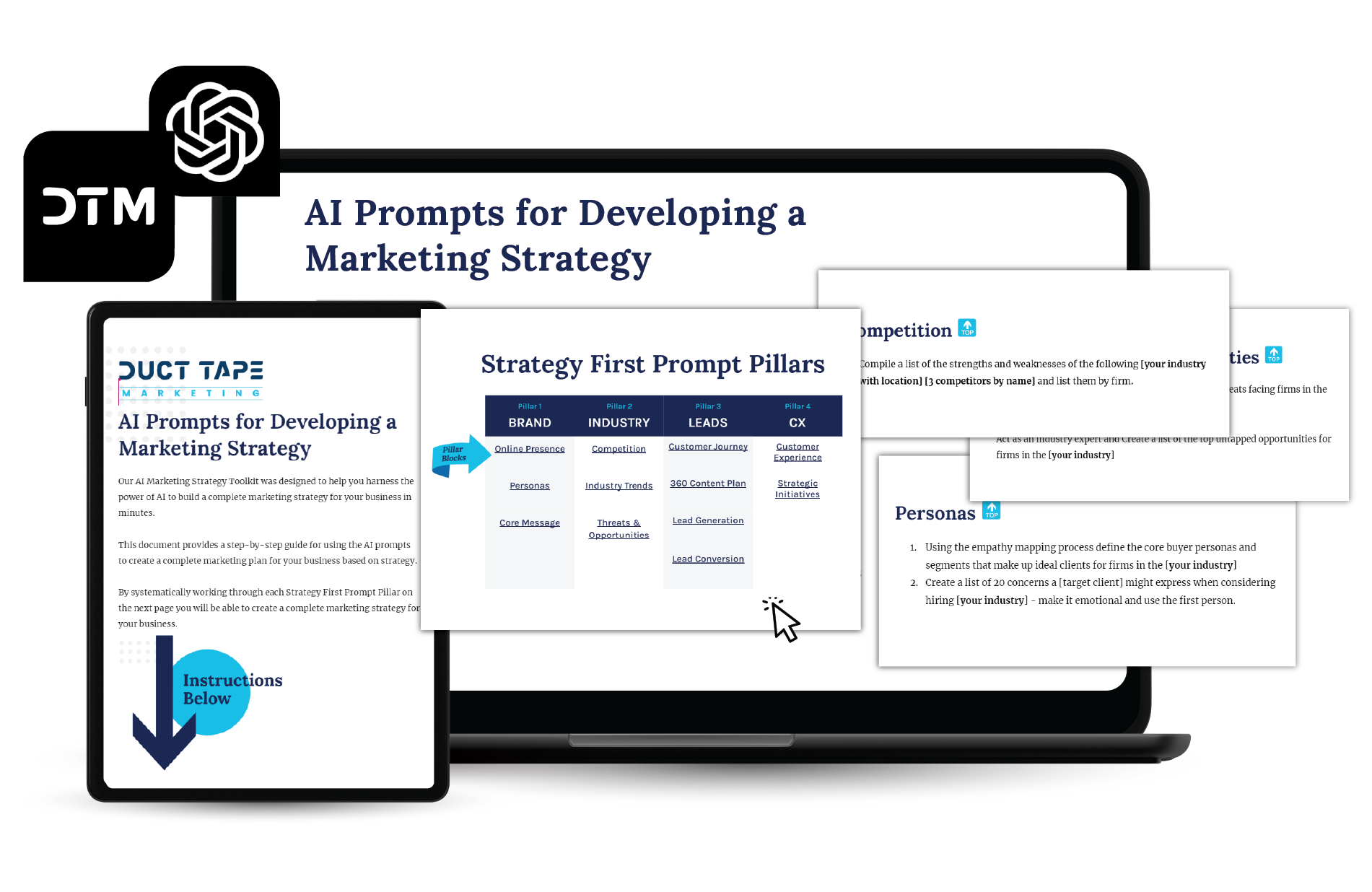As a marketing consultant, I meet numerous business owners who are all set to take their companies to new heights. But, I’ve also noticed a consistent pattern of confusion about what a marketing strategy truly entails. It’s a detailed plan designed by businesses to promote their product or service through different channels and tactics, in order to accomplish their business goals and understand their customer needs.
But, today I’m not just going to define it for you. Instead, let’s uncover the 10 symptoms indicating your business might be operating without a solid marketing strategy.
If you find yourself nodding along to any of these symptoms, it’s high time to collaborate with a strategic professional.
This is where the AI Prompts for Building a Marketing Strategy toolkit comes in!
This toolkit can help you develop a complete marketing strategy to overcome these symptoms. It’s a step-by-step approach designed to boost your marketing efforts, enhance customer retention, increase online visibility, and improve ROI.
Your marketing strategy should be the backbone of your business – a roadmap leading you toward your growth goals. By identifying your ideal customers, creating consistent branding, and tracking your performance, you can start working smarter, not harder.
1. Trying To Be All Things To All People
We’ve all been there. If I’m a dentist, anybody with teeth is my ideal client, right? But this approach, while maybe attracting clients, fails to identify your most profitable, ideal, and best customers. Without understanding this, how can you effectively attract more of them?
Instead focus on being the right thing to the right people.
The idea of being a universal solution might seem appealing initially, but the truth is, you can’t be all things to all people. In the world of business, it’s crucial to identify your specific target market – the people who will benefit the most from your product or service.
Who is your ideal client? What are their pain points? What can you offer them that your competitors can’t? By identifying and understanding your ideal client, you can tailor your marketing efforts to reach them more effectively instead of casting a wide net and hoping to catch something.
2. Lack Of Competitive Edge
Sound familiar? You’re a commodity. In your clients’ minds, every business that offers the same services is pretty much the same. If you’re just one of many, why should they choose you over ten others who look just like you?
Create one.
To prevent falling into the “commodity trap”, strive to create a unique value proposition. What makes you different? Why should clients pick you over competitors? Developing a distinct competitive edge doesn’t happen overnight, but it’s well worth the effort. It will allow you to stand out in your market, so you aren’t forced to compete solely on price.
3. Forced To Compete On Price
If your customers can’t distinguish how you’re different or unique, they’ll default to comparing prices. And as we all know, price is a terrible place to compete. There will always be someone willing to sell cheaper than you do.
Instead charge a premium.
If you’re struggling to differentiate your offering and find yourself competing primarily on price, you might need to reconsider your marketing strategy. The goal should be to provide such outstanding value that your customers are happy to pay a premium for your services.
Instead of lowering your prices to compete, consider how you can add more value. How can you make your customers’ lives easier, save them time, or help them achieve their goals? By focusing on value over price, you can charge a premium and boost your profitability.
4. Wasting Money And Resources
Without a clear strategy, you’re constantly testing the waters, never really sure what’s working. There’s a significant chance that most of your efforts aren’t producing the results you expect.
Make sure to resource allocation and track performance.
Where are your marketing dollars going? Are you spreading them too thin across too many platforms or channels without really knowing which one is driving results? A robust marketing strategy will include a clear plan for resource allocation backed by regular performance tracking. This approach ensures you’re investing your money and time in avenues that drive results and help you understand what works best for your business.
5. Inconsistent Branding
Branding isn’t just for large corporations or soap bars. It’s about how customers perceive your promise or your values. Inconsistent branding leads to confused customers; you either stand for nothing, or you represent confusion.
Be Consistent.
Inconsistent branding leads to confused customers, and confused customers seldom become loyal customers. Be clear about what your brand stands for, and make sure this message is consistent across all your marketing channels. This includes your website, social media platforms, email marketing, and even your offline marketing materials. Remember, the least expensive thing you can do is to get more business from existing customers.
6. Low Customer Retention
You’re losing customers as fast as you’re getting them. Remember, the most cost-effective marketing is getting more business from existing customers.
Enhance your customer retention.
It’s cheaper to keep an existing customer than to acquire a new one. By focusing on customer retention, you can increase your profitability. This might involve launching a loyalty program, consistently exceeding customer expectations. Here are some ways to make sure you’re always delivering an outstanding value to your customers.
7. Poor Online Presence
Today, every business is served by having a robust online presence. If your online presence is weak, it’s likely a symptom of a reactive and weak marketing approach.
Improve your online presence.
Today, an online presence is non-negotiable. But it’s not enough to just “be online”. You need to have a strategic approach to your online presence. This involves a well-designed, user-friendly website, an engaging social media presence, and maybe even a content marketing strategy that helps establish you as a leader in your field. You need a consistent online presence.
8. Untracked Performance
Do you have no clue what’s working and what’s not? Maybe business is fine, but you don’t know why or whether it will still be good tomorrow.
Set a tracking performance strategy.
A well-defined strategy allows you to set Key Performance Indicators (KPIs), like website traffic, leads, conversion rates, or customer retention rates. Tracking these KPIs provides invaluable insights into what’s working and what isn’t, enabling strategic adjustments.
Having a marketing strategy is about setting goals, tracking progress, and making necessary tweaks. Consistent performance monitoring assures your marketing efforts are steering your business in the right direction.
9. Missed Opportunities
Without a strategic focus on your ideal client, you miss the chance to serve them better. You also overlook the potential for partnerships and referrals.
Capitalize on opportunities.
Every customer interaction presents an opportunity. Are you making the most of these? Could you upsell or cross-sell? What about partnerships and referrals? Data tells that referrals have a 16% higher lifetime value rate, and a 37% higher retention rate than leads generated from other marketing channels. A marketing strategy helps you to spot and seize these opportunities.
10. Flat Sales And Profits
If your sales are flat, and your profits are flat or non-existent, you feel like you’re stuck in a rut.
Boost your sales and profits.
Lastly, if you find your sales and profits are flat, this is a sure sign you need to rethink your marketing strategy. Integrating sales with a well-executed marketing strategy can help you target your most profitable customers, differentiate your offering, and ultimately drive business growth.
Recognizing and admitting that you’re suffering from these symptoms is the first step towards a cure. The next step is taking action. And that’s where the AI Prompts for Building a Marketing Strategy toolkit can truly make a difference. Start creating your complete marketing strategy with this prompts and
see the difference a focused and efficient marketing strategy can make to your bottom line.
Are you ready to turn these symptoms into solutions?























































![Social Media Spring Cleaning [Infographic] Social Media Spring Cleaning [Infographic]](https://imgproxy.divecdn.com/9e7sW3TubFHM00yvXe5zvvbhAVriJiGqS8xmVFLPC6s/g:ce/rs:fit:770:435/Z3M6Ly9kaXZlc2l0ZS1zdG9yYWdlL2RpdmVpbWFnZS9zb2NpYWxfc3ByaW5nX2NsZWFuaW5nMi5wbmc=.webp)
![5 Ways to Improve Your LinkedIn Marketing Efforts in 2025 [Infographic] 5 Ways to Improve Your LinkedIn Marketing Efforts in 2025 [Infographic]](https://imgproxy.divecdn.com/Hv-m77iIkXSAtB3IEwA3XAuouMwkZApIeDGDnLy5Yhs/g:ce/rs:fit:770:435/Z3M6Ly9kaXZlc2l0ZS1zdG9yYWdlL2RpdmVpbWFnZS9saW5rZWRpbl9zdHJhdGVneV9pbmZvMi5wbmc=.webp)












